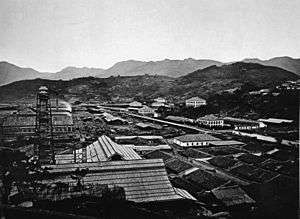Foochow Arsenal
| Foochow Arsenal | |||||||||
|
Foochow Arsenal (1870s) | |||||||||
| Traditional Chinese | 福州造船廠 | ||||||||
|---|---|---|---|---|---|---|---|---|---|
| Simplified Chinese | 福州造船厂 | ||||||||
| Literal meaning | Fuzhou Shipyard | ||||||||
| |||||||||
| Mawei Arsenal | |||||||||
| Traditional Chinese | 馬尾造船廠 | ||||||||
| Simplified Chinese | 马尾造船厂 | ||||||||
| Literal meaning | Mawei Shipyard | ||||||||
| |||||||||
The Foochow Arsenal, also known as the Fuzhou or Mawei Arsenal, was one of several shipyards in Qing China as part of the Self-Strengthening Movement. The shipyard was constructed under orders from Li Hongzhang and Zuo Zongtang and was situated in Mamoi (now Mawei), a port town within the jurisdiction of Fuzhou (then romanized as "Foochow"), which is several miles up the Min River.[1][2]
History
Planning for the shipyard, the Fuzhou Naval College (t 船政學堂, s 船政学堂, p Chuánzhèng Xuétáng, w Ch‘uan-cheng Hsüeh-t‘ang), and other facilities began in 1866. Construction began in 1867. Two French Naval officers, Prosper Giquel and Paul d'Aiguebelle, both on leave from the French Imperial Navy, were contracted to recruit a staff of about forty European engineers and mechanics, and to oversee the construction of a metal-working forge, the creation of a Western-style naval dockyard, the construction of eleven transports and five gunboats, and the establishment of schools for training in navigation and marine engineering—all within a five-year period.[3][4][5][6] Chinese authorities provided the materials and labour;[7] The number of labourers rose from an initial figure of 1600 to more than 2000 by 1872.[8] the operating cost over the five years was estimated at 3 million taels, and the cost of maintenance of the ships produced was partly funded by revenue from duties on the import of opium.[9] The first ship produced at the Arsenal, the 150-horsepower Qing Forever (t 萬年清, s 万年清, p Wànnián Qīng, w Wan-nien Ch‘ing), was launched in June 1869.[10]
The shipyard was almost entirely destroyed by French forces in 1884 during the Sino-French War of 1883-1885,[11] in the battle of Fuzhou. A modern shipyard was later rebuilt on the site.[12]

See also
References
Citations
Bibliography
- Hong Kong Port and Maritime Board. "Chinese Ports 1996: Fuzhou; Harbour Plan". Accessed 26 September 2002.
- "Fuchow" in the Encyclopædia Britannica, 11th ed., 1911.
- Pong, David. "Keeping the Foochow Navy Yard Afloat: Government Finance and China's Early Modern Defence Industry, 1866-75". In Modern Asian Studies, vol. 21, no. 1 (Cambridge University Press, 1987).
- Seltzer, Leon E., ed. The Columbia Lippincott Gazetteer of the World (New York: Columbia University Press, 1952).
- Thomson, John. China and its People in Early Photographs: An Unabridged Reprint of the Classic 1873/4 Work (reprint, New York: Dover Publications, 1982).
- Viénet, René. L'épisode français peu connu des Pescadores. Accessed 24 September 2002.
